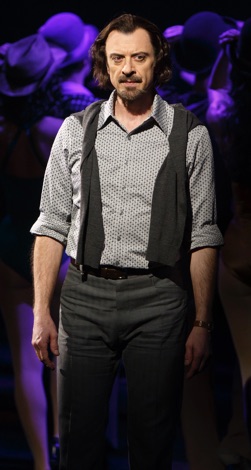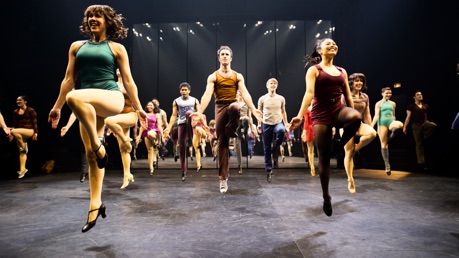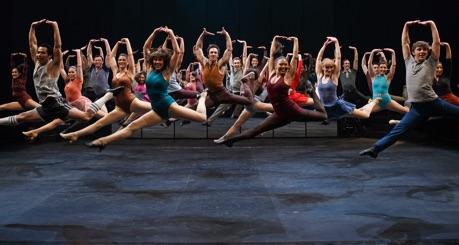Reviews 2016






✭✭✭✭✩
music by Marvin Hamlisch, lyrics by Edward Kleban, book by James Kirkwood & Nicholas Dante, directed by Donna Feore
Stratford Festival, Festival Theatre, Stratford
May 31-October 30, 2016
Zach: “It would be better if I knew something about you”
The first thing to say about A Chorus Line in its first-ever staging at Stratford is that the dancing is fantastic. Since the show is primary a dance musical, the dancing is reason enough to see it. The second thing to say is that some aspects of the 1975 musical have aged well and others have not. The basic premise of the action is suspect and attempts late in the evening to try to create a plot for what is essentially a plotless show seem forced. What does survive is its glimpse into the lives of dancers, their passion, the humiliations of the audition process and the cruel brevity and unprofitability of such a career.

To have a director ask job applicants, which are what these dancers are, to reveal personal information in front of their peers might have seemed acceptable in 1975 when people still held encounter groups, but from the perspective of today it seems unacceptably invasive. Of what possible use is it to Zach’s decision about who stays and who goes to know what made any of the 17 what to be come a dancer? He is supposed to be judging them on their physical ability, not on how well they can speak about themselves (not a requirement for the job) or worse, what they say about themselves. Unfortunately, the second part is what Zach is interested in. He encourages the dancers to talk not just about their personal lives, but their experiences with sex, sexual orientation, body image, religion and a host of other topics that ought to be off limits in any interview.
The reason for this cringeworthy premise is to provide some excuse for the dancers to speak about themselves. Today we have become used enough to plotless musicals that we no longer need the structure of public confessional interviews. As the characters each speak for themselves in Sondheim’s Assassins (1990), so the dancers could speak for themselves in A Chorus Line if the book writers had had the wit to think of it. Perhaps for this reason director and choreographer Donna Feore and designer Michael Gianfrancesco decided to set the musical in 1975 rather than the present. Also the characters’ allusions to such stars as Cyd Charisse, Anna May Wong and Ann Miller or to the Ed Sullivan Show would hardly be likely coming from the twentysomethings of today.

The stories of the 17 are the substance of the show. Many of the 17 like Chad McFadden as Don and Matthew Armet as Greg are people we’ve actually seen in dance choruses before who we are glad to see have a turn in the spotlight at last. Standouts among the group include Matt Alfano as Mike, who starts the show off with such a fantastically athletic solo tap number in “I Can Do That” that nothing later ever quite reaches so high a level. Ayrin Mackie as Sheila, as the tallest female dancer and one who is already 30, always holds our attention. Her character exudes a cynical attitude because she’s been through auditions so many times before. But when Zach insists, she sings the song “At the ballet” with a full voice and expressiveness about how the beauty of ballet gave her some respite from the ugliness of life at home with her warring parents.
As Mark, the youngest dancer, Colton Curtis relates with a fine sense of comedy how his character loved to study an anatomy book which eventually led to his first wet dream and a self-diagnosis of gonorrhoea. Matthew Armet also displays a fine sense of humour when he explains how his character Greg discovered he was gay. The best part about Greg’s story and the reaction of Zach and the others is that they treat it as no big deal.
Julia McLellan’s Val likely has the most notorious song of the show, “Dance: Ten; Looks: Three” with its refrain “Tits and ass”. Risqué at the time, now merely amusing, McLellan delivers the song and dance with all the sassiness they require. The irony is that a song about submitting to lookism in entertainment is so upbeat.
As Al, Gabriel Antonacci clearly has the finest voice among the men. It’s rather too bad, then, that he main number is finishing the lines of Alexandra Herzog’s nervous Kristine in the song “Sing!”. Cynthia Smithers, whom some will recall as one of the corps de ballet for Opera Atelier, proves she has other talents. She has the finest singing voice among the women and as Diana delivers the most moving song of the evening, “What I Did For Love” with real conviction.
As Paul, Conor Scully has to make his main impression through acting. He has to deliver the long narrative about how the young Puerto Rican boy discovered and tried to hide his love of drag. It stops the show dead and ultimately has no point except that it reflects the life story of one of the writers of the book. Its practical function is to give the cast a rest before the final dance number. Its dramatic function is to manipulate us into feeling something for this young man so that his later injury and exit from the audition stirs up emotion. Scully does the best he can with this story and makes it as sincere as possible, but there is no disguising that the story is overlong and, by today’s standards, not that interesting.

As Zach and Cassie, Juan Chioran and Dayna Tietzen plays the only two roles in the show listed as leads. Chioran well plays Zach as an uncompromising but benevolent dictator. Zach is a more complex character than Feore allows him to be. Even in a period-set production of A Chorus Line, we really should know why a director wants to pry so deeply into the secrets of 17 people, nine of whom he will dismiss. Tietzen delivers Cassie’s main song “The Music and the Mirror” well, but her big solo dance meant to illustrate her star ability is a very hectic and awkward piece of choreography filled with multiple backbends and Tietzen can do little to make it flow or appear remotely natural. The dialogue that book-writers James Kirkwood and Nicholas Dante give Zach and Cassie about their past relationship is stilted and melodramatic and a clunky attempt to inject the show with plot at the last minute.
Though the show is located on a bare stage and is meant to have no scenery, placing the show in the Festival Theatre ironically means that a set has had to be built to look like a bare stage. Designer Michael Gianfrancesco has created a back wall of revolving panels with black bricks on one side and mirrors on the other. Thus, the location of the action seems to switch back and forth without much reason from the bare back stage to a rehearsal studio even though it is meant to be the same space.
With an expanded stage floor on top of the Festival stage with even the voms filled to near level with it, interest in the design relies heavily on lighting. Michael Walton imaginatively deploys an arsenal of almost every technique available from roving spotlights to rotating gobos to enhance the diverse moods of every song and dance number.
Donna Feore’s choreography is as athletic and diverse as usual and combines influences from jazz to ballet to ballroom. Much has been made about Feore’s adapting the show to a thrust stage, but patrons need not worry. The stage has been widened so much that Feore still gives us the iconic 19-member gold-clad kick-line straight across the stage opening.
For all the flaws of its premise, A Chorus Line lives on because it provides such a spectacular display of dancing as well as revealing unpleasant truths about the life of dancers that most theatre-goers tend to forget. After all the hard work striving for perfection, there is no steady job, there is no pension, there is no hope for a long career and even less hope for stardom. The greatest irony of the show is that after getting to know the dancers as individuals, their goal is to suppress their individuality completely in a sequence of unison dancing for the song “One” meant to highlight not them but the “real” star of the show.
That final irony has great impact in this production. While many may look at the final kick-line as a sort of triumph, others may wonder how much sadness lies behind the show-ready smiles of those who devote their lives to the performing arts.
©Christopher Hoile
Note: This review is a Stage Door exclusive.
Photo: (from top) Cast of A Chorus Line; Jouan Chioran as Zach; Bonnie Jordan, Matt Alfano and Genny Sermonia and the cast; cast of A Chorus Line. ©2016 David Hou.
For tickets, visit www.stratfordfestival.ca.
2016-06-01



A Chorus Line





